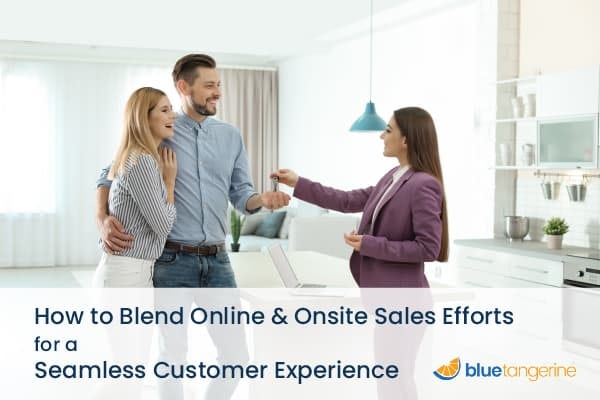It seems like just yesterday that we were talking about the need for online salespeople in the homebuilding industry. In reality, it’s been more than ten years ago, and a lot has changed since then. Most homebuilding companies have in fact, added online sales teams to their sales efforts, but consumers continue to evolve in the way they engage with companies. It seems that buyers’ expectations are changing faster than we are. Our onsite sales teams and our online sales teams may now be playing tug of war with each other. We must be careful that the customer isn’t the one who is losing out.
How to Blend Online & Onsite Sales Efforts For a Seamless Customer Experience

The Original Online Sales Strategy
When we added online salespeople to our sales strategies, we simply inserted them into the linear process which we’ve been using for decades. If a customer wanted to engage with us online, we now had online salespeople that could answer questions, send requested information, and set appointments using text messages, email, online chat, or by phone, depending on how the customer wanted to communicate. Our goal was still to get the buyer to visit our onsite sales team. After all, homebuyers don’t buy homes online, do they? Well, of course, they do, but most of us didn’t have processes for those buyers. The reality is that most homebuilders still don’t offer a way for buyers to buy online.
Our online sales teams weren’t expected to actually sell anything, even though we called them the online sales team. Their job was to get the buyer to agree to visit the onsite salesperson at the community. Once the online salesperson got the buyer to agree to an appointment, his or her job was complete. The linear process now moved into the “hand-off” phase. When the buyer went in and met the onsite salesperson, the hand-off was complete, and the online salesperson was no longer involved with the buyer.
This process worked for a long time. In fact, this is how many homebuilders still operate. To be clear, it is smart to have a concerted effort for converting online leads into onsite visits for the sales team. The issue is that customers don’t like to be treated like leads. They expect a certain level of service regardless of their current position in someone’s sales funnel.
Evolution of Customer Engagement
Let’s go back and look at the evolution of customer engagement for a moment. The old linear approach will no longer work for most consumers. Today, buyers engage with a company online, then they may choose to visit onsite, and oftentimes, they are back online again. We can relate because we’re all consumers and we’ve all grown accustomed to doing business when it’s convenient for us, even if it’s outside of a company’s traditional business hours. It’s no longer enough to offer multiple channels in a linear approach to customer service.
In other words, today’s consumer doesn’t want to hear that they can’t engage with the online salesperson because they’ve already visited the onsite salesperson in the community. After the customer visits the community, he or she may have more questions or more decisions to make and they expect the same level of engagement and attention online as they received prior to their in-person visit.
The challenge for many homebuilding companies is that their onsite sales team isn’t set up ideally for real-time engagement over multiple channels. Onsite salespeople aren’t able to respond instantly to text messages, email, online chat, or answer their phones, the same way as the online salesperson does. After all, they are busy meeting with people in person onsite, which is why we created online sales teams in the first place. Once the customer has been handed-off to the onsite sales team, they are often required to engage with the company when the salesperson is able to respond. Sometimes that may take a few hours or even a few days.
The Sales Disconnect
As you can see, there is often a disconnect between our online sales efforts and our onsite sales efforts, and it’s rooted in the way we set up the two processes. We don’t usually give any responsibility or authority to the online sales team for sales. Remember, they are here to convert online leads into appointments. We expect them to schedule appointments and that’s the way we compensate them. Some online salespeople are paid a bonus if the appointment leads to a contract, but that’s to ensure a more qualified lead is being scheduled for appointments. They’re not being compensated for sales.
Once the hand-off occurs, the online salesperson returns to his or her list of online prospects and engages to set more appointments. After all, this is their core responsibility. They are here to convert leads into appointments for the sales team. It is the responsibility of the onsite salesperson to convert the online lead to a sale and they are the ones who are compensated for the sale. Many times, the onsite salesperson doesn’t want anyone else communicating with “their prospect” because they don’t want anyone else to interfere with their chances of making the sale. In this type of dichotomy, the online sales team is tasked with setting appointments only and the actual sales effort is left exclusively to the onsite sales team.
In this world, the customer can no longer communicate with the online sales team because the online sales consultant’s work is done after the appointment is kept. They have handed off the prospect to the onsite sales agent who now has all responsibility and authority over the prospect. Once the customer crosses the threshold of the sales center, they now “belong” to the onsite sales team. If they reach out again to the online salesperson, they are usually given the name and email address for their onsite agent and referred back to them. They no longer have anyone online to help them.
This isn’t the omnichannel approach today’s buyer expects.

I spoke to a friend recently who was relocating. She found a homebuilder in the city where she was moving who offered an online “buy now” option. After completing their search, her family decided to purchase the home online. Later, she chose to visit the community and told the onsite agent of her plans to purchase online. My friend told me the onsite agent talked her out of buying online, even though she was buying the exact same home, in the exact same community, from the exact same homebuilder. She told me that she didn’t understand why the onsite sales agent talked her out of buying her home online.
Why does this continue to happen?
I have an opinion about why this continues to happen. Continuing with my friend’s example, I believe it probably has something to do with the way that homebuilder compensates their salespeople. I believe that an onsite salesperson would probably be paid a higher commission if the sale originated onsite but would probably receive a reduced commission or no commission if the purchase was made through the “buy-now” mechanism with the online sales team. This isn’t necessarily the onsite salesperson’s fault. They are working within the confines of their company’s processes.
Another possibility is that the onsite salesperson didn’t believe the customer would be happy with the experience of buying through the online option. This is merely speculation on my part. The reality is that, for whatever reason, the onsite salesperson didn’t want my friend to buy online. That homebuilder obviously didn’t have a blended sales effort between their onsite sales team and their online sales team.
The problem with this is that it penalizes the buyer and forces them to choose between doing business online or onsite. Today, we should have systems in place that allow our customers to engage in a non-linear way. We should be able to offer an outstanding customer experience to those buyers who want to engage with us online, even after they have visited us onsite. I don’t think we can continue to look at our online sales effort as just a way to convert online leads for our onsite sales teams.
Creating the Seamless Customer Experience
The way to blend the online sales effort and the onsite sales effort is to ensure that there are processes in place that allow for a non-linear customer experience. The sales efforts must work together throughout the process, regardless of how or when the customer makes a buying decision. It’s no longer about how the online salesperson hands off the buyer to the onsite salesperson. Maybe we should eliminate the hand-off altogether. Homebuilders will need to look at their processes from the inside, out. It’s not enough to add a “buy now” button to the website and to create a way to take payments electronically. Homebuilding companies will need to look at the entire sales effort, including compensation and responsibility and authority for customer experience. These may need to be shared throughout the entire customer’s journey.
Buyers are indeed changing the way they buy. The companies that create processes to blend their sales efforts between online sales and onsite sales will begin to see an increase in their customer satisfaction surveys and will begin to capture more margin and more market share as they exceed their customers’ expectations. These happy customers will undoubtedly share their experiences with their friends and family (in-person and online)!
There are many companies in the homebuilding industry and in other industries that have successfully blended their online and onsite sales efforts and they are reaping the rewards. There are many other companies that still have not made the evolution.
If you’re interested in creating blended sales processes and training your onsite and online sales teams on blended sales efforts that will exceed your customers’ expectations, please reach out to us today at SalesUncomplicated.com.

You can hear more from David in Episode #103 of The Home Builder Digital Marketing Podcast: Adapting Sales to the Buyer and the Market.

